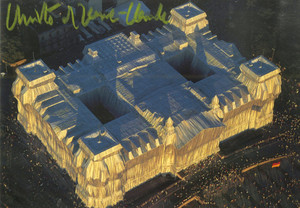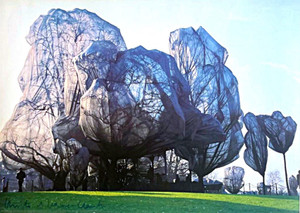
Christo and Jeanne-Claude, The Umbrellas Japan-USA (Hand Signed) from the private collection of Jeanne-Claude's former assistant, 1991
Christo (Christo and Jeanne Claude)CONTACT GALLERY FOR PRICE
Christo and Jeanne-Claude
The Umbrellas Japan-USA (Hand Signed) from the private collection of Jeanne-Claude's former assistant, 1991
This is a self-published private card promoting Christo and Jeanne-Claude's project "The Umbrellas Japan-USA", bearing Christo's 1991 copyright. (photograph by Wolfgang Volz). It was hand signed Christo and Jeanne Claude and given to Susan Astwood, Jeanne-Claude's former assistant. Authenticity guaranteed.
ABOUT THE UMBRELLAS JAPAN-USA PROJECT:
At sunrise, on October 9, 1991, Christo and Jeanne-Claude's 1,880 workers began to open the 3,100 umbrellas in Ibaraki and California, in the presence of the artists at both sites. This Japan-USA temporary work of art reflected the similarities and differences in the ways of life and the use of the land in two inland valleys, one 12 miles (19 kilometers) long in Japan, and the other 18 miles (29 kilometers) long in the USA.
In Japan, the valley is located north of Hitachiota and south of Satomi, 75 miles (120 kilometers) north of Tokyo, around Route 349 and the Sato River, in the Prefecture of Ibaraki, on the properties of 459 private landowners and governmental agencies. In the USA, the valley is located 60 miles (96.5 kilometers) north of Los Angeles, along Interstate 5 and the Tejon Pass, between south of Gorman and Grapevine, on the properties of Tejon Ranch, 25 private landowners as well as governmental agencies.
Eleven manufacturers in Japan, USA, Germany and Canada prepared the various elements of the umbrellas: fabric, aluminum super-structure, steel frame bases, anchors, wooden base supports, bags and molded base covers. All 3,100 umbrellas were assembled in Bakersfield, California, from where the 1,340 blue umbrellas were shipped to Japan.
Starting in December 1990, with a total work force of 500, Muto Construction Co. Ltd. in Ibaraki, and A. L. Huber & Son in California installed the earth anchors and steel bases under the supervision of Site Managers Akira Kato in Japan and Vince Davenport in the USA. The sitting platform-base covers were placed during August and September 1991. From September 19 to October 7, 1991, an additional construction work force began transporting the umbrellas to their assigned bases, bolted them to the receiving sleeves, and elevated the umbrellas to an upright closed position. On October 4, students, agricultural workers, and friends, 960 in USA and 920 in Japan, joined the work force to complete the installation of The Umbrellas. Each umbrella was 19 feet 8 inches (6 meters) high and 28 feet 5 inches (8.66 meters) in diameter.
Christo and Jeanne-Claude's 26 million dollar temporary work of art was entirely financed by the artists through their The Umbrellas, Joint Project for Japan and U.S.A. Corporation (Jeanne-Claude Christo-Javacheff, president). The artists do not accept sponsorship. All previous projects by Christo and Jeanne-Claude have been financed in a similar manner through the sale of the studies, preparatory drawings, collages, scale models, early works, and original lithographs.
The removal started on October 27 and the land was restored to its original condition. The umbrellas were taken apart and most of the elements were recycled.
The Umbrellas, free standing dynamic modules, reflected the availability of the land in each valley, creating an invitational inner space, as houses without walls, or temporary settlements and related to the ephemeral character of the work of art.
In the precious and limited space of Japan, the umbrellas were positioned intimately, close together and sometimes following the geometry of the rice fields. In the luxuriant vegetation enriched by water year round, the umbrellas were blue. In the California vastness of uncultivated grazing land, the configuration of the umbrellas was whimsical and spreading in every direction. The brown hills are covered by blond grass. In that dry landscape, the umbrellas were yellow.
From October 9, 1991 for a period of eighteen days, The Umbrellas were seen, approached, and enjoyed by the public, either by car from a distance and closer as they bordered the roads, or by walking under The Umbrellas in their luminous shadows.







